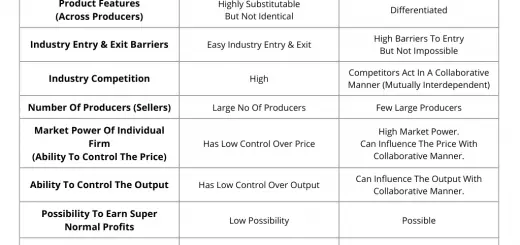Monopolistic Competition: Real Examples in USA, Canada, World
In a monopolistic competition market, firms offer products or services that are highly similar, highly substitutable, but not identical. A large number of producers/sellers are available in a monopolistic competition market. High competition is a result of low barriers to entry in a monopolistic competition market.
Following are some real examples of monopolistic competition in the United States, Canada, Australia, and the World.
Real Examples of Monopolistic Competition in the United States, Canada, Australia, and the World
1. Hairdressers in the USA
The service provided by the hairdressers is one of the most famous types of examples of monopolistic competition. According to ibisworld.com, there are 904,718 Hair Salons Businesses in the US. Some examples include Supercuts, Great Clips, Cost Cutters, Cookie Cutters, Fantastic Sams, Snip-its, etc.
The customer base is distributed among these large number of hairdresser companies. Each of the hairdresser companies has a slightly different type of expertise area and each one of them sells a slightly differentiated product to the customers.
2. Shoe Production Market in Canada
There are several reputed shoe producers in Canada. Some famous brands are Vessi, Casca Designs, Call It Spring, Zvelle, Matt & Nat, and John Fluevog.
The competition in the shoe market is very high. Many companies in the market produce substitutable products.
3. Fast Food Restaurants in Australia
There are many restaurants on any own in the world. In Australia, there are many restaurants including Brae, Lulu La Delizia, Attica, OTTO, Shobosho, Quay, Ester, Aubergine, and Fico.
All the restaurants offer food for the customers, which is a substitutable product. But the price offering of the restaurants depends on many factors such as the quality, location, and services. This is the product differentiation among the different restaurants.
4. Bakery Shops in America
There are certainly a lot of bakeries in all states and towns in the USA. Each one of them sells slightly differentiated products. Paradise Bakery & Cafe, Bouchon Bakery, Lost Larson, and Carissa’s The Bakery are some of the examples, but plenty more are available.
Relatively there is a very low entry barrier for setting up a new bakery shop which is one of the important characteristics of the monopolistic structure.
5. Grocery Shops in Canada
Grocery stores exist in a monopolistic competition market with low barriers to entry and a high number of rivalries. Also, an individual grocery shop has very low power to influence the market output and price. Typical examples of Grocery Shops in Canada are Atlantic Superstore, Fortinos, Nesters Market, Axep, Dominion, Bloor Street Market, Les Entrepôts Presto, and Extra Foods.
6. Fast Food Industry in the United States
There are many companies in the United States Fast Food Industry. McDonald’s, Subway, Burger King, and Pizza Hut are some players in the market. There are fewer barriers to entry for the Fast Food Market. Also, one company can not influence the fast-food output or fast-food price.
All the companies mentioned above sell fast foods which are highly similar in terms of fulfilling a customer’s need, but the products are not identical.
7. Online Electronics Retailers in the USA
There are many companies in the online electronic retail market in the USA. There are very low entry barriers to starting an online electronic retail website and store. Amazon, BestBuy, Walmart, MicroCenter, Crutchfield, and Kroger are some typical examples of these.
Read More:
Market Structures
Monopolistic Competition
- Overview, Definition, & Features of Monopolistic Competition
- Main Characteristics / Causes of Monopolistic Competition
- Advantages and Disadvantages of Monopolistic Competition
Monopoly Market
- Definition, Examples, and Characteristics of Monopoly Market
- Real Examples of Monopoly Market (in the USA, Canada, Australia, World)
- Important Characteristics / Causes of Monopoly Market
- Advantages and Disadvantages of Monopoly Market
Oligopoly Market
- Definition, Types, and Characteristics of Oligopoly Market
- Real Examples of Oligopoly Market (in the USA, Canada, World)
- Seven Important Characteristics of Oligopoly Market
- Advantages and Disadvantages of Oligopoly Market
Perfect Competition


